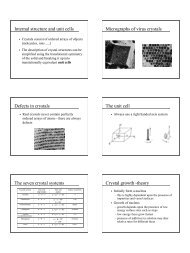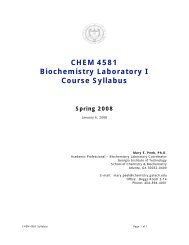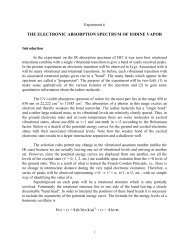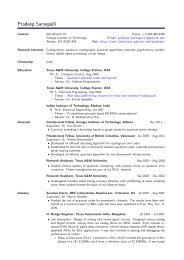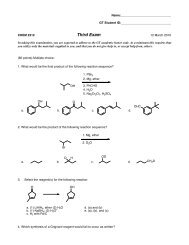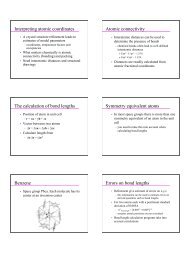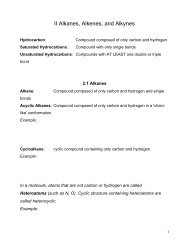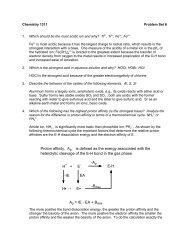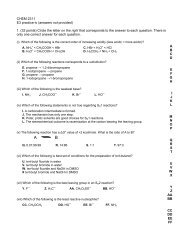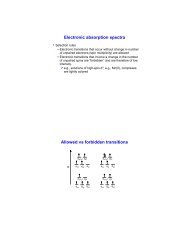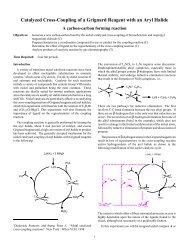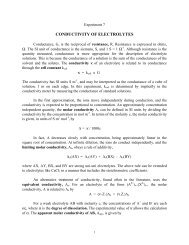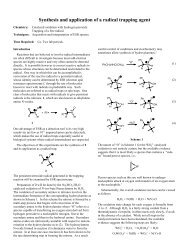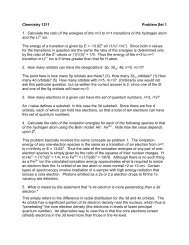Create successful ePaper yourself
Turn your PDF publications into a flip-book with our unique Google optimized e-Paper software.
Name:_____________________________<br />
GT Student ID:_____________________________<br />
CHEM 2312 Second <strong>Exam</strong> 22 February 2010<br />
In taking this examination, you are expected to adhere to the GT academic honor code. At a minimum this requires that<br />
you utilize only the materials supplied to you, and that you do not give help to, or accept help from, others.<br />
(60 points) Multiple choice:<br />
1. What would be the major product of the following reaction<br />
CO 2 H<br />
NO 2<br />
HNO 3<br />
H 2 SO 4 , heat<br />
a.<br />
CO 2 H<br />
NO 2<br />
b.<br />
NO 2<br />
CO 2 H<br />
c.<br />
NO 2 O 2 N<br />
NO 2<br />
CO 2 H<br />
NO 2<br />
O 2 N<br />
d.<br />
CO 2 H<br />
NO 2<br />
2. What would be the major product(s) of the following reaction sequence<br />
OH<br />
1. SOCl 2<br />
O<br />
2. C 6 H 6 , AlCl 3<br />
3. Zn(Hg), HCl, heat<br />
OH<br />
O<br />
O<br />
OH<br />
a. b. c. d.<br />
3. Which reagent(s) would you use to convert toluene to benzyl bromide<br />
a. Br 2 , FeBr 3 b. N-Bromosuccinimide, ROOR, hν c. HBr d. Br 2 /CCl 4 e. NaBr, H 2 SO 4<br />
4. The common name for 4-methylphenol is which of these<br />
a. catechol b. p-cresol c. resorcinol d. p-xylene e. hydroquinone
5. What final product is expected from the following reaction sequence<br />
1. Fe/HCl<br />
NO 2<br />
2. NaHCO 3<br />
Cl<br />
3. Br 2 /H 2 O<br />
4. HONO, 0-5°C<br />
a.<br />
Cl<br />
Br<br />
OH<br />
5. H 3 PO 2<br />
Br<br />
Br<br />
NO 2<br />
b. c. d.<br />
Cl Br Cl<br />
Cl<br />
Br<br />
PO 2 H<br />
Br<br />
HO 2 P<br />
e.<br />
Cl<br />
Br<br />
NO<br />
6. Which of the following might be used to synthesize m-bromoaniline<br />
a.<br />
1. HNO 3 , H 2 SO 4<br />
2. Fe, HCl<br />
3. NaOH, H 2 O<br />
4. Br 2 , H 2 O<br />
b.<br />
1. Br 2 , FeBr 3<br />
2. HNO 3 , H 2 SO 4<br />
3. H 2 , Pt<br />
c.<br />
1. HNO 3 , H 2 SO 4<br />
2. Br 2 , FeBr 3<br />
d.<br />
3. H 2 , Pd-C<br />
1. HNO 3 , H 2 SO 4<br />
2. Fe, HCl<br />
3. NaNO 2 , HCl<br />
4. CuBr<br />
7. Consider the synthesis below. What is compound B<br />
Br<br />
NO 2<br />
A<br />
B<br />
C<br />
NH 2<br />
Br<br />
Br<br />
Br<br />
a.<br />
NO 2 NH 2<br />
NO 2<br />
NH 2<br />
b. c. d.<br />
e.<br />
Br Br<br />
Br<br />
Br<br />
8. Which of the following would be the strongest acid<br />
a.<br />
OH<br />
OH<br />
OH<br />
b. c. d.<br />
H<br />
O<br />
OH<br />
e.<br />
H 3 CO<br />
OH
9. Which product is likely to be obtained during the following reaction of the isotope-labeled allyl ether<br />
( 14 C-isotopic site marked with an asterisk)<br />
O 200°C<br />
*<br />
<br />
O OH OH OH OH<br />
a. b. c. d.<br />
e.<br />
*<br />
* * * *<br />
10. Which of the following would be most likely to undergo a nucleophilic substitution reaction with aqueous<br />
sodium hydroxide by an addition-elimination mechanism<br />
a.<br />
Cl<br />
NO 2<br />
Cl H 3 CO Cl<br />
Cl<br />
b. c. d. e.<br />
O 2 N<br />
O 2 N<br />
Cl<br />
OCH 3<br />
NO 2<br />
11. What products(s) would you expect from the following reaction<br />
Cl<br />
NaNH 2<br />
NH 3 (l), –33°C<br />
NH 2 NH 2<br />
CH 3<br />
CH 3 Cl<br />
a.<br />
CH 3<br />
NH 2<br />
CH 3<br />
Cl<br />
CH 3<br />
b. c. d.<br />
H 2 N<br />
e.<br />
CH 3<br />
NH 2<br />
f. products (a) and (b) g. products (d) and (e)<br />
12. Which method could be used for preparing methoxybenzene from phenol<br />
a. NaOH, then CH 3 I b. NaOH, then CH 3 OCH 3 c. NaOH, then NaOCH 3 d. more than one of these
13. (16 points) In the following reaction sequence fill in all missing reagents and intermediates A-D:<br />
A<br />
NBS<br />
Cl<br />
ROOR<br />
B<br />
C<br />
HBr<br />
Cl<br />
ROOR<br />
D<br />
14. (24 points) The following transformations cannot be performed in a single step. Provide a sequence of<br />
reactions to perform each transformation, showing the reagents and structures of all isolated synthetic<br />
intermediates. You may assume that mixtures of isomers can be separated. Note: each synthesis requires<br />
3 or more steps. Do NOT provide mechanisms, just the synthetic steps.<br />
a)<br />
Br
)<br />
OH<br />
Br<br />
CH 3<br />
CH 3




